How often have you seen ladder companies quickly deploy the aerial but delay or completely neglect throwing ground ladders?
Always and never do not fit into the fire service vocabulary. At any working fire on arrival, the conditions and structure type will dictate tactics. You will not always position on side A to put the aerial in service. On the other hand, en route to a working fire in a row home, your officer should not say, “Regardless of fire conditions, never deploy ground ladders to side C.” You may use your aerial often in the downtown of a major metropolis. In the Fairfax County (VA) Fire Rescue Department, most structure fires we run occur in buildings of three stories or fewer.
RELATED FIREFIGHTER TRAINING
Ground Ladders, Not Just for Egress
Truck Company Basics: Ground Ladders
Truck Company Operations: Boston’s Ladder Culture
Throw Back to Basics: Ground Ladder Tip Placement
As the captain, lieutenant, driver/operator, or firefighter on a truck company, size up the scene on arrival to determine the mission and tactics. Don’t discount the aerial entirely because the structure is not a mid-rise or high-rise. Ensure that you position the aerial appropriately so it is ready to perform rescue if needed or if fire conditions change drastically and require defensive operations. If you are the exterior crew on a truck company and the aerial is not one of your first offensive tactics, you should be deploying ground ladders for rescue, ingress, and egress.
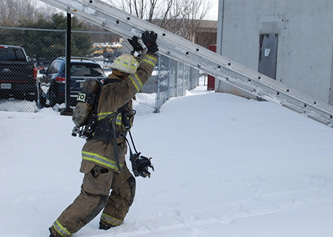
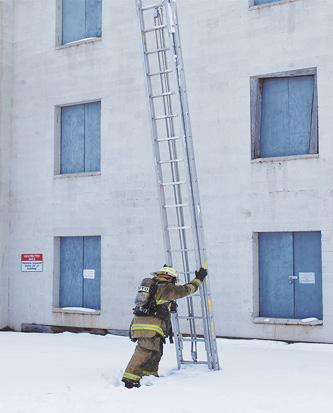
(1-2) A freestanding ladder throw with a 35-foot ladder. [Photos courtesy of Fairfax County (VA) Fire Academy.]
Know Your Ground Ladders
No matter what your department size or staffing, your members should work on one- and two-person throws with your ladder complement. Although you will need several firefighters for 40- and 50-foot ladders, many techniques for 35-foot or shorter ladders require one or two firefighters.
The workhorse of the fire service is the easily deployable 24-foot extension ladder, which is on every engine company and can handle most residential jobs. As an apparatus technician, I worked on a ladder truck with heavy-duty ladders that were also heavy on the shoulder; the 35-foot weighed 139 pounds. I did train to deploy this ladder alone, since we had only three firefighters on our trucks at the time. But if I did not need the bigger ladder, my go-to play was to grab as many ladders off the engine companies as I could. Remember, the 24-foot and 14-foot ladders marry quite well on one shoulder.
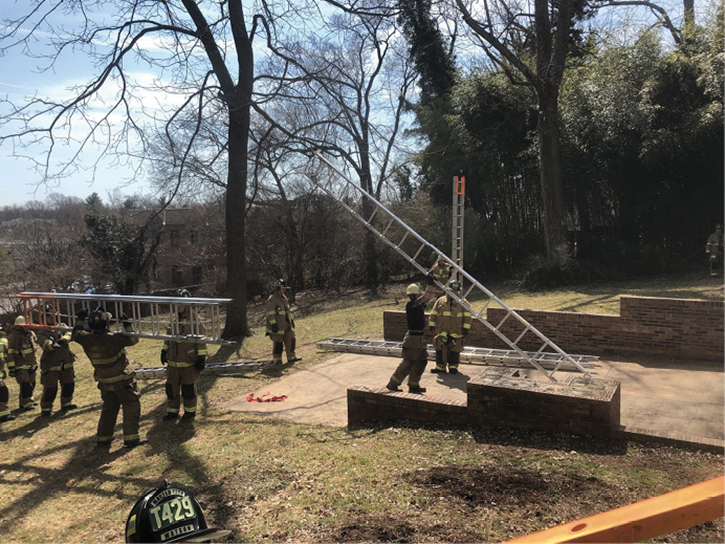
(3) The “Statue of Liberty” raise with a 20-foot ladder on a hard surface at an acquired structure during a truck operation school.
Once the ladder truck has been positioned for possible aerial use, focus on the ground ladders. When selecting a ground ladder from your ladder truck, what are you working with? When did you last train with these ladders or deploy them on a working incident? How much do they weigh, how long are they, and how many of each ladder does your truck company carry?
If you run mutual or automatic aid, where’s the next-due truck coming from? What ladders do they carry? How many engine companies are dispatched on a box alarm in your jurisdiction? Will their ladders be accessible? Answering questions like these will help you and your company to formulate a plan of attack when you need to deploy ground ladders. Whether your next closest truck company is from your department or responding as mutual aid, understand how they operate on fire incidents.
Aerial Awareness
How quickly can your company put the aerial into service vs. deploying ground ladders? Does your truck have scissor jacks or H-style jacks, and how many—four or two? The truck company I am currently assigned to is a tractor-drawn aerial (tiller). It only requires two outriggers, and you can put the aerial in service relatively quickly. I still would not favor deploying the aerial vs. deploying several ground ladders. This depends on realizing that at the time of deployment, the aerial is not the primary tactic choice.
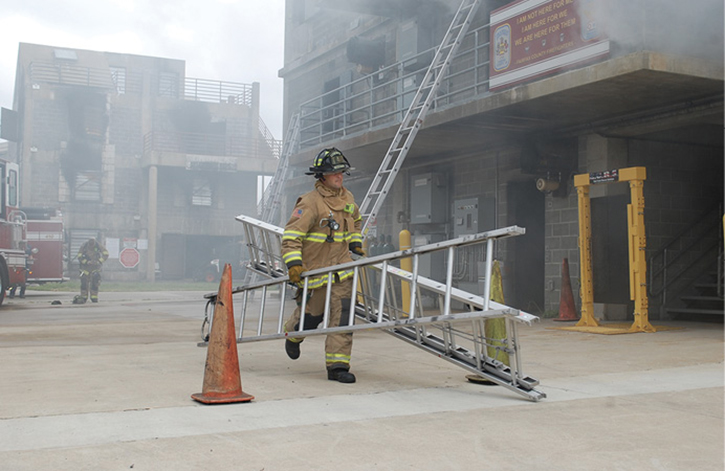
(4) A firefighter deploys 24-foot and 14-foot ladders during training.
Ground Ladders vs. Aerial
Consider the following working incident concerning crew resource management and tactics, in which improper tactics were used. We responded to a mutual-aid jurisdiction for a reported fire on the top floor of a three-story garden-style apartment. On arrival, the second-due truck company’s driver and tillerman performed ground ladder size-up on sides A, D, and C. The first-due truck had not thrown any ground ladders. The first-due truck driver was setting the jack plates for aerial deployment. The second-due truck officer and firefighter proceeded inside for search. The exterior crew of the second-due truck (driver and tillerman), deployed six ground ladders to cover the structure sides A and C. Radio information indicated that a roof cut may be needed. The driver and the tillerman access a saw and other tools for roof work and climb a 35-foot ground ladder to the roof. As they make it to the peak, the aerial from the first-due truck is finally extended to the roof line.
There are two points here. First, with the conditions presenting on this call, the aerial was not needed as a first, second, or even third tactic. With a garden apartment fire, ground ladders are required for at least two sides and usually multiple floors. Conditions can change quickly, and ladders could be our best means of ingress and egress. Second, it is indisputable that the ground ladders were quickly deployed to sides A and C and the roof before the aerial from the first truck was placed in service. Deploying the aerial immediately as the first-due truck on this specific fire incident was a poor tactical decision. Roof ventilation or a second means of egress was not the first-due truck’s primary duty. Several windows needed ground ladders to be placed to them before any roof ventilation would be needed, not to mention the possibility of deploying a handline over a ground ladder rather than pollute the interior stairwell. Fortunately, in this specific area of operation, resources are heavy, and the mission was accomplished.
Changing the Culture
How do we change the culture of “Working fire! Put the stick up?” It starts with you! If you are at a truck house, ride in the bucket of the truck, chauffeur the truck company, or happen to be the boss of the truck, then you have a vote. Of course, if you are the battalion chief or district chief, your vote could affect several companies. First, if you are out there on the line running the calls, you need to get your hands dirty and work on throwing ground ladders in all types of conditions and situations. Unless you are on a nonemergency call, you should be throwing these ladders in complete personal protective equipment (PPE)—bunker gear, fire gloves, and a helmet at a minimum.
When you are proficient and confident at this level, try those same throws while wearing your self-contained breathing apparatus (SCBA); it changes things significantly. Think of this as the stress exposure or stress inoculation training. Become competent in deploying ladders from the rig to the house and then throwing the ladder up to your target. When your heart rate is starting to rise, think about the next step. This could include but not be limited to vent-enter-isolate-search (VEIS), remote entry search from a ladder to upper floors, roof ventilation operations, window removal for horizontal ventilation from the ladder, one- and two-person throws, uneven terrain, and emptying the bed competitions.
Truck School
In 2019, at the Fairfax County (VA) Fire and Rescue Academy, one of my tasks was designing and teaching a truck school. I decided that ground ladders would be the primary subject along with search to complement this topic. Along with the other field training officers, I designed a curriculum on search and ground ladders, taught over one year, and involved all 14 truck houses across our three shifts.
Our department has seven rear-mount towers, three straight trucks, and four tiller trucks. Our tiller trucks carry a large complement of ground ladders, which are all relatively light in weight. Our straight trucks and towers, for the most part, have the heavier ladders in our industry. We intended that truck company houses attend school no matter what apparatus they were on that day—trucks, towers, rescues, engines, or medic units. We had acquired structures to use in our county for the duration of the school and trained more than 400 personnel.
Our approach was based on the Marine Corps teaching style: lesson, demonstration, application. We felt it was that important to train our members on ground ladders no matter what their tenure, background, or experience. The course involved a slideshow presentation to re-engage the crews and build or sometimes rebuild the foundation, followed by a demonstration of every throw we would use. We let the crews practice the throws we had demonstrated in full gear but without SCBA. In the last phase, all members would pair up for a full-scale VEIS in gear and on air. For the final training scenario, the crews were split according to unit (e.g., engine, truck, rescue, medic) and had to ladder eight targets labeled with spray paint or signs on all four sides of the house. These targets were at different heights and were labeled victim, smoke, and fire and sometimes assigned to a specific company as their objective.
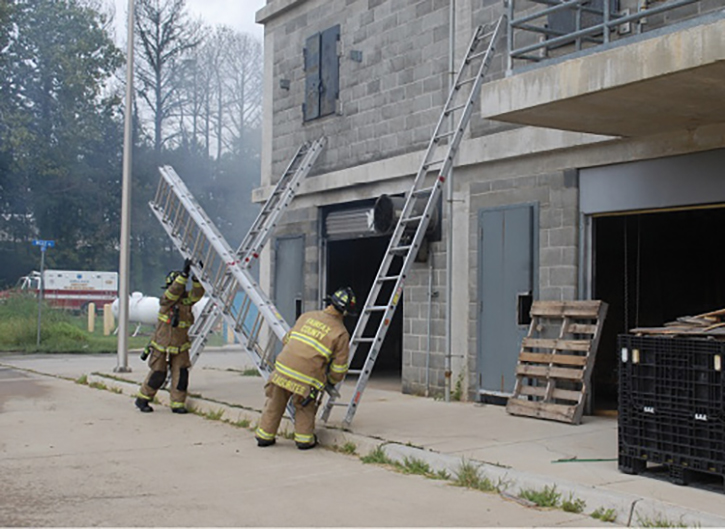
(5) Two firefighters perform a beam raise with a 28-foot ladder.

(6) Ladders are deployed at an acquired structure to various labeled targets: victim (V), smoke (S), fire (F).
The takeaways were as follows. First, firefighters and officers from all walks of life and levels of experience inherently want to do a good a job. It may take one or two individuals to pick up the ladder for the first throw, but almost all will follow in some fashion. Sets and reps are what we do and are the key to competence. We must train on ground ladders as frequently as we do hoselines. I gave these crews their first contact with the throws in the classroom, demonstrated them in person, and then assisted them as they practiced the throws. I reminded them that this was just one day of training; they must continue to train to master a specific skill.
As the training continued, the trainees’ confidence rose. When the evolutions ramped up and their heart rate rose to 115-145 beats per minute (bpm, condition red), individuals became locked in at the immediate task—e.g., VEIS. When the last training evolution was to be performed with company vs. company, crews were tired mentally and physically. There were many variables— ladder weight; weather; structure size; terrain; and, most importantly, the human factor.
On the positive side, you could see crews pulling together as a team to achieve a common goal of deploying eight ground ladders in full PPE and SCBA. On the negative side, some members were more exhausted for whatever the reason and most likely operating with heart rates of 145-175 bpm (condition gray) or even above 175 bpm (condition black). When exhaustion set in and heart rates rose, we saw no one quit or give up. Instead, we saw some people on complete autopilot, doing what needed to be done with some aggravation and outbursts but mostly firefighters helping one another to accomplish a common goal.
The most interesting though not-too-surprising observation with the elevated heart rates and exhaustion was the almost immediate reliance back to whatever skill set was most ingrained in the individual’s psyche. Once faced with a given task in this “condition,” the firefighters would immediately revert to previous lessons learned, even if it was the least efficient and more energy-consuming technique. Therein lies the proof that you must put the time and sweat in to take yourself to the next level of proficiency. Do not allow yourself to become docile and complacent.
We use three levels to grade our department members in competencies annually: Outstanding, Satisfactory, and Unsatisfactory. How would you and your company rate in ground ladder deployment? We should all strive to be outstanding, but without reality-based training and continually honing our craft, we will all inevitably fall to Unsatisfactory.
Brian T. Wood is a 16-year veteran of the fire service and the lieutenant on Truck 425 A-shift with the Fairfax County (VA) Fire and Rescue Department. He served as field training officer at the Fairfax County Fire Training Academy and is a lead instructor for Adapt and Overcome Training, LLC.

